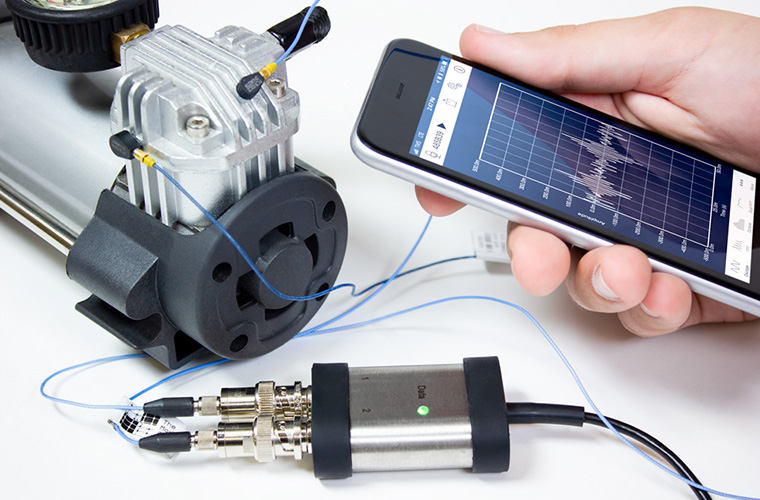Main Menu
- Home
- Product Finder
- Calibration Systems
- Calibration Services
- Digital Sensing
- Industrial Vibration Calibration
- Modal and Vibration Testing
- Non-Destructive Testing
- Sound & Vibration Rental Program
- Learn
- About Us
- Contact Us
 The Modal Shop recently received an inquiry that led to an interesting discussion about the number of input channels available when using a Digital ICP USB Signal Conditioner Model 485B39. The customer was looking for a simple measurement system to quantify customer NVH complaints in the field and easily share with a vibration expert offsite. The question arose, “Why is Digital ICP USB Signal Conditioner just two channels? What if I want to use a triaxial accelerometer with a mobile device to capture this data?”
The Modal Shop recently received an inquiry that led to an interesting discussion about the number of input channels available when using a Digital ICP USB Signal Conditioner Model 485B39. The customer was looking for a simple measurement system to quantify customer NVH complaints in the field and easily share with a vibration expert offsite. The question arose, “Why is Digital ICP USB Signal Conditioner just two channels? What if I want to use a triaxial accelerometer with a mobile device to capture this data?”
Let’s start with the question of the number input of channels available. For users with a test background, the idea of having 4 channels for testing with a triaxial accelerometer and even adding a microphone certainly sounds appealing. So, why bring in a 2-channel system? Working in the field brings challenges that don’t exist in the lab environment. It may make sense to keep things simpler since more channels lead to more data, which in turn leads to more complexity. One could argue that a tremendous amount of troubleshooting is possible by using 1 or 2 channels and using them wisely. This first-pass assessment with a high-resolution snapshot of data can allow you to see if there is an issue and decide to take action or determine the need for further investigation.
Beyond the need for simplicity in the field, pairing the Digital ICP USB Signal Conditioner with a mobile device means that it’s easy to add GPS location, notes, pictures of where and how the data was measured, etc., and share that data with an analyst located offsite. In addition, by keeping things to 2 channels, the mobile device itself can power the Signal Conditioner and the 2 sensors, meaning the measurement can be made without being connected to any other power supply.
What about adding another Signal Conditioner? Mobile devices typically limit input to two channels, so if you add a second 2-channel Signal Conditioner, you will need to connect the devices to a PC. The challenge with this is that the USB ports on a PC are not perfectly in sync with each other. If phase is important to you, this timing difference can be a problem – when using a triaxial accelerometer, for example, you likely want to capture all 3 axes at the same time. If the small time difference between channels 1 and 2 and channels 3 and 4 is not a concern, then two Signal Conditioners can be used at once.
If portability, low cost, and flexibility are less important than the need for synchronized data across 3 or more channels, then you will need to use one of the many 4 or greater channel systems available on the market. These systems will typically be PC-based, require proprietary drivers and/or software, and may require external power.
Please consider the above as food for thought as you pursue a mobile measurement system. Digital ICP USB Signal Conditioner Model 485B39 offers an ultra-compact, low-power, and cost-effective measurement solution to make field assessments easier. All over the world, companies are experiencing the benefits of adding Digital ICP USB Signal Conditioner Model 485B39 to technician toolkits, bringing high-quality, high-resolution data collection into the field.